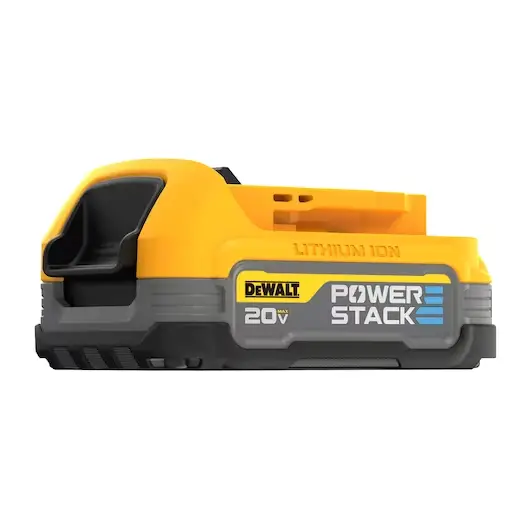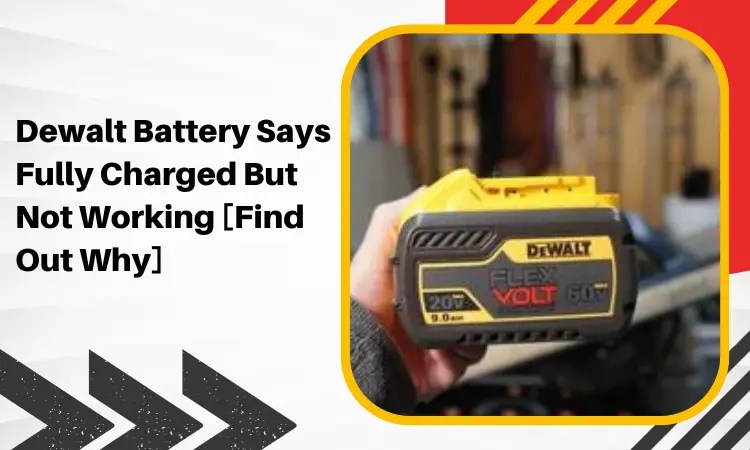Your Dewalt Battery says fully charged but not working for the following reasons
- The battery is overheated
- Voltage is low
- The cell is not properly balanced
- The battery cell is damaged
- Rust or corrosion build up in the battery
To fix these issues, you can maintain the battery properly by storing them properly in a cool place, charging the battery, and checking their voltage level. But if the battery is damaged at an extreme level then it is better to get it replaced.
If you want to get further details on understanding battery condition and maintaining it for a long time then keep reading this article.
Why Does My Dewalt Battery Says Fully Charged But Not Working?
The table below shows some of the common reasons why a Dewalt battery is fully charged but does not work.
| Reasons | Solutions |
| Overheating Shutdown | Store the Battery in a Cool, Dry Environment |
| Low Voltage | Charge the Battery, Replace the Battery |
| Cell Imbalance | Put a Battery Management System (BMS), Check Cell Voltage |
| Cell Damage | Replace Dewalt Battery |
Overheating Shutdown:
Temperature plays a big role in how well Dewalt batteries work. If it’s too hot or too cold, it can mess up the battery and make it not work as well. Cold weather can make the battery not hold as much power and make it take longer to charge.
On the other hand, hot weather can make the battery wear out faster and even be dangerous, like causing short circuits or explosions. So, make sure to keep the battery stored properly.
Solution: Store the Battery in a Cool, Dry Location
Beware of storing the lithium-ion Dewalt batteries in 20 to mid-40 degrees. This can severely impact the functionality of the battery.
To solve problems with Dewalt batteries caused by temperature, keep them in a cool, dry place when storing or charging. Try not to let them get too hot or too cold, and if they get dirty, clean them gently with a damp cloth.

If the battery still has temperature issues, you can check the thermistor or ask a professional for help. Always use real Dewalt batteries to make sure they work well and are safe to use with Dewalt tools
Low Voltage:
The power of Dewalt batteries can be affected by low voltage, which happens when the tiny power cells inside don’t have enough energy. Imagine these cells like small power tanks—they’re fully charged at 4.2 volts but can drop to 2.5 volts when they’re almost out of power.
If the cells go below this range, they can get damaged and lose their ability to hold a charge. Dewalt batteries have many of these cells, and the weakest one determines how much power the whole battery can store. So, if even one cell has low voltage, it can make the whole battery pack not work as well.
Solution: Charge the Battery
If low voltage is a common problem with the battery then you need to charge it. Make sure to keep the battery in a properly charged condition and follow the user manual for more.
If your Dewalt battery is not charging then you can check it:
If the low voltage persists despite the battery charging then take it to a technician or just replace the battery.
Cell Imbalance:
Cell imbalance plays a significant role in impacting the functionality of Dewalt batteries, influencing both how well they perform and how long they last. When the cells within a battery pack are not in balance, it triggers various issues.
Firstly, it results in reduced capacity, meaning the battery can only be charged to its full potential or used once it’s empty, ultimately diminishing the overall power the battery pack can provide.
Additionally, cell imbalance puts extra stress on the battery, causing the cells to wear out and degrade more quickly. This accelerated wear and tear can significantly shorten the lifespan of the battery pack.
Moreover, there are potential safety risks associated with imbalanced batteries. These risks include the possibility of overheating or short-circuiting, both of which can lead to undesirable and unsafe conditions.
Solution 01: Put a Battery Management System (BMS)
Incorporating a battery management system (BMS) into your battery maintenance routine. A well-designed BMS plays a crucial role in balancing the individual cells within the battery pack, promoting optimal performance, and extending the overall lifespan of the battery.
Solution 02: Check Cell Voltages
To check the voltage of individual cells in a DeWalt battery, you can follow these steps:
Disassemble the battery: Carefully take apart the DeWalt battery, paying attention to how the cells are arranged and connected.
Identify the cells: DeWalt batteries have a specific arrangement of cells, which you can recognize by their markings and connectors. For instance, 18V DeWalt batteries typically have four 3.7V cells connected in series.
Connect the multimeter: Set your multimeter to measure DC voltage. Attach the multimeter probes to the correct cell connectors, making sure you measure the voltage across each cell.
Measure the voltage: Note the voltage readings for each cell. Ideally, a fully charged battery should read around 21V, while a partially charged one may show about 20.5V.
Analyze the results: Compare the voltage readings with the expected values for your specific battery model. If you notice any significant deviations, it could indicate a problem with the battery.
If you want a video demonstration then check this
Bonus: Check out this comparison between Dewalt and Bosch table saw.
Cell Damage:
It is possible that through prolonged use that cell has gotten damaged. Cell damage in Dewalt batteries can occur due to various factors such as excessive cell pressure, exposure to high temperatures, and high voltage levels within the battery.
Visible damage or cracks in the battery should not be overlooked, as they not only impact performance but also pose potential safety hazards, necessitating prompt replacement.
Lastly, improper storage conditions, including exposure to liquids, oils, or extreme temperatures, can contribute to cell damage, emphasizing the importance of storing batteries in cool, dry environments.
Solution: Replace Dewalt Battery
When the cell is damaged, it is better to just replace it.

Do the following
- Disassemble the battery
- Remove the old cells
- Prepare the new cells
- Install the new cells
- Reassemble the battery
How Do I Know If My Dewalt Battery Is Bad?
To determine if your DeWalt battery needs replacement, follow these steps:
Measure the fully charged voltage: Ideally, a fully charged DeWalt battery should have a voltage of 21V, with a good voltage at 20.5V. Any reading below 20V may indicate a problem.
Test the battery’s power level: Insert the battery into the power tool, hold down the trigger, and assess its power level. If it appears underpowered, it could signal the need for replacement.
Perform a runtime test: Use a constant load tool, such as a blower or vacuum, to conduct a runtime test and evaluate the battery’s performance under real-world conditions.
Use an electronic load tester or capacity tester: These devices can provide more detailed information about the battery’s capacity and overall performance.
Check for visible damage or cracks: Avoid using batteries with visible damage or cracks, as they pose safety risks and should be replaced.
Examine the battery’s performance: After about an hour in the charger, assess the battery’s performance. DeWalt battery chargers typically have a one-hour charge cycle, delivering a full-charge battery in up to 60 minutes.
It’s advisable to replace your DeWalt battery if you encounter poor performance during these tests.
Bonus: Find out how you can your sharpen table saw blades.
How to Avoid Dewalt Battery Issues?
To keep your DeWalt batteries in top shape, here’s what you should do:
Use genuine DeWalt batteries: Stick to authentic DeWalt batteries for the best performance and to ensure they work seamlessly with your DeWalt tools.
Proper storage is key: Keep your batteries in a cool, dry place, away from liquids, oils, or extreme temperatures.
Give them a clean: A gentle wipe with a clean, damp cloth is all your batteries need. Avoid using harsh solvents.
Dispose of old batteries responsibly: If your battery isn’t holding a charge anymore, take it to a nearby DeWalt Service Center for safe and free disposal.
Don’t run them down completely: Stop using a battery as soon as you notice a significant drop in power. Running it down completely could cause damage.
Watch your charging habits: Don’t leave batteries in the charger for too long, as it might lead to damage. Use the maintenance mode charging feature to keep your pack fully charged until you’re ready to work.
Handle transportation carefully: If you’re shipping batteries, follow the proper guidelines, especially for FLEXVOLT batteries – engage the red transport cap.
Keep an eye out for visible damage: If your battery shows any signs of damage or cracks, it’s a safety risk. Replace it to stay on the safe side. But once you replace it, make sure that the saw can properly detect your fingers while working.
FAQ
How to Jumpstart a Dead Dewalt Battery?
To jumpstart a dead Dewalt battery, transfer power from a live battery. All you have to do is disconnect the wires from the live battery and place the dead battery in the tool’s battery charger. Wait for a few minutes and see if the battery receives charging or not. You can also a car battery charger to jumpstart the dead Dewalt battery.
Why Do My Dewalt Batteries Keep Dying?
Your Dewalt batteries keep dying because of dirty contacts or the battery keeps getting overheated from excess use. Besides the battery can also stop working if it exceeds its expiration date. So please make sure to check the expiry date before you try to troubleshoot the Dewalt battery.
What is the Life Expectancy of a Dewalt Battery?
The life expectancy of a Dewalt battery is two to three years. The longevity of the batteries depends on the pack charge during storage, storage conditions, and the charge cycling period. Normally, if you store the battery and maintain it properly then the Dewalt battery is going to last a little bit longer.
Conclusion
In conclusion, the Dewalt battery remains fully charged but does not work for technical reasons like overheating, low voltage, or just incompatibility. But make sure to diagnose the battery properly and then solve the problem. Hopefully, through this guide, you can easily troubleshoot and have a fully functioning Dewalt battery.
I am Tony Darryl, a woodworker and handyman with over 8 years of experience. My years of work have allowed me to have knowledge that I can share with others. I will tell you in detail about this or that process because it is important to do it safely for you.
Carving, working with different types of blades, metal cutting, and woodworking – this is what I specialize in, and I will help you understand these processes.



